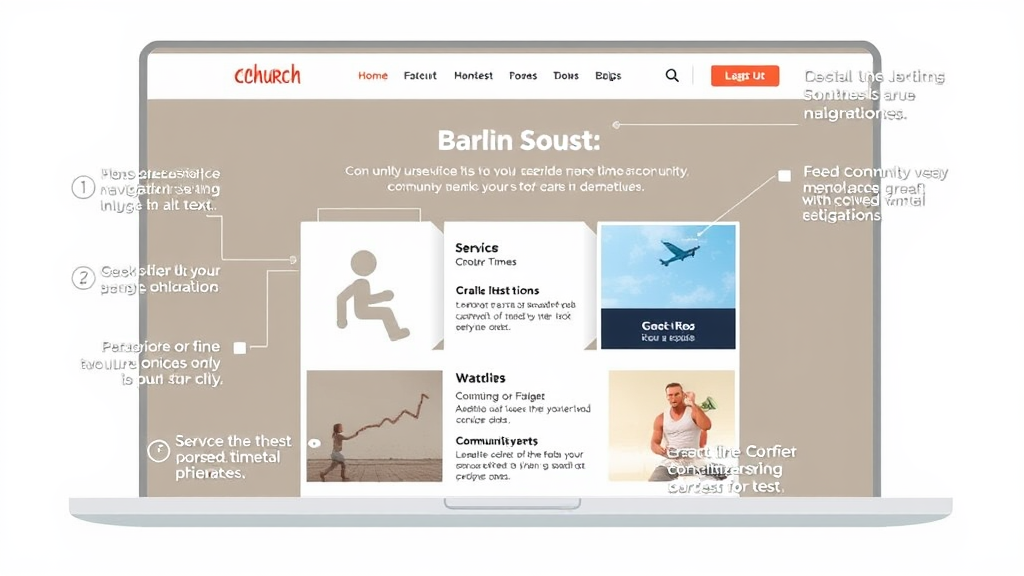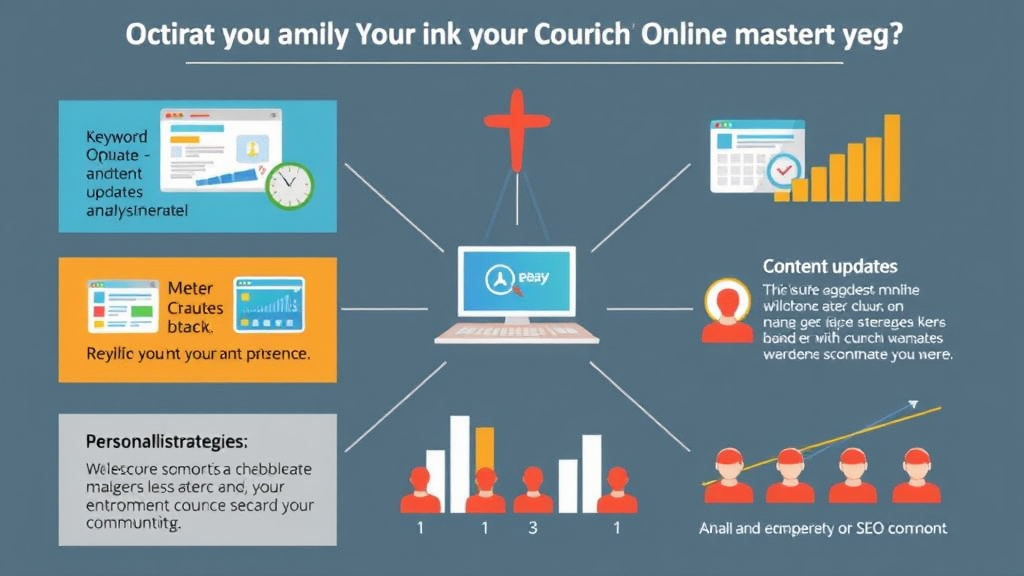A professional Christian web design plays a critical role in amplifying your ministry by enhancing visibility, accessibility, and community engagement. In today's digital age, a church website serves as a central hub for vital information and helps to convey the values and identity of a congregation, ultimately fostering spiritual growth and outreach.
Key Takeaways
- Purpose of a Church Website: Acts as a communication channel, central hub for info (service times, activities), and enhances community engagement.
- User Experience Focus: Prioritizes accessibility, usability, and alignment with the church’s values; includes important design features like mobile optimization, clear CTAs, and engaging content.
- Cost Considerations: Vary from DIY solutions (approx. $1,000/year) to professional designs (around $3,900/year).
- Impact on Ministry Growth: A well-designed website fosters community, enhances digital giving, and supports outreach efforts through integration with social media and SEO.
- Continuous Improvement: Ongoing testing and optimization ensure the site remains relevant and effective.
Start your journey towards a modern and effective website with ipsom.io.
The Importance of Professional Christian Web Design
Professional Christian web design serves as the foundation for effective online ministry. A well-crafted website enhances a church's visibility and allows it to engage effectively with its community. In today's digital landscape, an average of 75% of users judge the credibility of an organization based on its web design. This makes the visual presentation of your church paramount to building trust and attracting visitors.
Enhancing Online Visibility
A church website acts as a central communication channel for its community. It provides vital information such as service times, events, and ways to connect. By ensuring that the church's website is optimized for search engines, congregations can enhance their visibility online. Websites that meet accessibility standards and are easy to navigate contribute to a positive user experience, leading to increased attendance and participation.
Reflecting Christian Values
Design elements including colors, typography, and imagery should embody the core Christian values of peace, hope, and love. When a website aligns with the ministry's mission and objectives, it enhances authenticity. Visitors are more likely to engage with a site that resonates with their beliefs and values. Strategic use of design components not only communicates a welcoming environment but also reflects the church's commitment to its mission.
Key Components of Effective Church Websites
Creating an effective church website hinges on several key components that enhance usability and engagement. A user-friendly website helps visitors navigate easily, find relevant information, and connect with the church community. By implementing thoughtful design strategies, churches can create an online presence that truly reflects their mission and values.
User-Centric Design
User-centric design prioritizes the experience of visitors. A well-structured website with intuitive navigation allows users to easily access essential information such as service times, contact details, and event announcements. Each page must have a clear purpose, guiding visitors toward their needs and ensuring a satisfactory experience. Studies show that 47% of users expect a web page to load in two seconds or less; this emphasizes the need for efficient design that caters to user expectations.
Accessibility Features
An effective church website must be accessible to everyone, including individuals with visual and hearing impairments. Considerations like keyboard navigation, descriptive alt text for images, and color contrast ensure that content is accessible to all users. Statistics indicate that about 1 in 5 people have a disability; thus, making accessibility a priority broadens your reach and fulfills a moral obligation to serve the community.
Engaging Content Presentation
Content presentation plays a vital role in engagement. Utilize thoughtful font choices and strong visuals to create emotional connections with your audience. Structuring content for quick skimming aids users with varying reading styles. Use headings, bullet points, and short paragraphs to make vital information easy to digest. Engaging content not only keeps visitors on your site longer but encourages them to return and participate in community activities.
Strategic Website Design Decisions
- Importance of Strategic Decisions: Essential for creating an effective church website.
- Choosing the Right Platform:
- Plays a significant role in the website's functionality and ease of use.
- Platforms designed for church needs should include features like:
- Sermon management
- Event calendars
- Popular options:
- WordPress
- Wix: Both offer customizable options for easy maintenance and updates.
Streamlined Functionality
- Maximizing User Experience:
- Incorporate features like:
- Contact forms: Simplify communication with the congregation.
- Online donation buttons: Facilitate financial contributions.
- Digital Giving Methods:
- Must be clear and secure for enhanced fundraising efforts and financial transparency.
- An accessible website fosters user confidence and encourages engagement with the church community.
- Incorporate features like:
Social Media Integration
- Broadening Reach and Engagement:
- Connecting the website to social media platforms enhances visibility.
- Share inspirational content and invite participation in upcoming events.
- This approach:
- Keeps the congregation informed.
- Fosters a sense of community.
Implementing these strategic design components will lead to a more effective and engaging church website, ultimately supporting the growth of the ministry.
Optimizing for Growth and Engagement
To optimize for growth and engagement, it's essential to implement proven strategies that will elevate your church's online presence. SEO best practices play a crucial role in ensuring your website remains visible in search results. By focusing on keyword optimization, metadata, and internal linking, you can significantly enhance your site's chances of being discovered by potential visitors.
Regularly update your site's content with relevant keywords that align with your ministry's mission. This practice keeps your site ranking well within search engines and helps connect with your audience. To strengthen your SEO efforts, you can explore strategies detailed in our resource on SEO for small businesses.
Monitoring and Adaptation
Using analytics tools to track user behavior and site performance is essential for ongoing optimization. Analyze metrics such as page views, bounce rates, and user engagement rates to understand how visitors interact with your site. Utilize this data to adapt your content and design according to feedback and the evolving needs of your ministry. Regular assessments keep your website relevant and valuable to your community.
Personalization Strategies
Implementing personalization strategies can greatly enhance user engagement on your church website. Tailor user experiences based on demographics and behavior to provide relevant content. Consider offering resources such as sermon databases and daily devotionals that add value to visitors' experiences. Personalization fosters a deeper connection and encourages repeat visits, ultimately strengthening your congregation’s community.
The Role of Graphic Design in Ministry
Importance of Aesthetically Pleasing Design
- Vital Communication Tool: Aesthetically pleasing design enhances communication within ministry.
- Simplifies Complex Ideas: Attractive graphics make complex concepts easier for congregants to understand.
- Alignment with Mission: When visual design aligns with the church's mission, it fosters trust and recognition.
- Brand Loyalty Impact: Studies show that consistent branding can increase customer loyalty by up to 23%.
- Investment in Design: Investing in compelling graphic design is essential for effective ministry outreach.
Practical Steps for Effective Graphic Design
To ensure effective graphic design, consider the following steps:
-
Define Your Brand:
- Identify your brand's mission, values, and unique qualities.
- Establish foundational elements that represent the church.
-
Utilize Design Tools:
- Use tools like Adobe Suite or Canva, depending on your skill level.
-
Collaborate with Professionals:
-
For significant projects, consider working with professional graphic designers.
-
Elevate your church's branding with expertise that resonates with your community.
Maximizing Engagement through Visual Communication
-
Engaging Visuals: Create visuals that resonate with your audience across various platforms:
- Web: Optimize graphics for your church website.
- Social Media: Tailor visuals for posts that connect with your followers.
- Print Materials: Design brochures, flyers, and newsletters that attract attention.
-
Incorporate Multimedia:
- Use video and multimedia content to enhance message delivery and relatability.
-
Nurturing Community Connections: Effective visuals help promote events, share sermons, and spread inspiration, nurturing community ties.
- Improve Engagement Rates: A strong visual strategy can significantly boost engagement, making it a crucial aspect of your ministry's communication efforts.
FAQ
How can a professional church website improve my ministry's reach?
A professional church website enhances reach by serving as a central communication hub. It provides essential information about services, events, and community activities, making it accessible to both members and newcomers. With effective SEO strategies, the website also improves visibility on search engines, increasing the likelihood of attracting new visitors and fostering community growth.
What should I consider when selecting a platform for my church's website?
When selecting a platform, prioritize features tailored for church needs, such as sermon management and event calendars. Usability is key; choose a Content Management System (CMS) that allows for easy updates and maintenance. It’s essential to consider responsiveness for mobile users, community engagement tools, and templates that reflect your church's values.
Why is SEO important for a church website?
SEO is crucial for a church website as it improves search visibility. Effective keyword optimization and metadata help the website rank higher in search results. This can lead to an increase in organic traffic, allowing your church to reach more people interested in spiritual resources and community activities.
How can I ensure my church website is accessible to everyone?
To ensure accessibility, implement design elements that support users with varying abilities. Use alt text for images, ensure keyboard navigation, and provide transcripts for audio and video content. Conduct accessibility audits and adhere to the WCAG (Web Content Accessibility Guidelines) to make the site usable for all individuals.
What design elements should reflect my church's identity online?
Design elements should include colors, typography, and imagery that convey peace, hope, and community values. Use symbols and graphics aligned with your church’s mission to enhance authenticity. A consistent design across all pages strengthens your brand identity and creates a welcoming online atmosphere.
How often should I update content on my church website?
Content should be updated regularly to keep the information fresh and relevant. Weekly updates for events and activities, monthly blog posts, and periodic reviews of static pages are recommended. This not only helps with SEO but also encourages visitors to return for new content and stay engaged with your ministry.
What are the costs associated with professional church web design?
Professional web design can range from $1,000 per year for DIY options to approximately $3,900 per year for comprehensive services. Costs depend on features like custom design, ongoing maintenance, and additional tools (such as donation systems or sermon hosting). It’s important to assess budget and needs before moving forward.
How can I effectively engage with my church community through my website?
Engagement can be fostered by integrating features such as online donation options, event registrations, and community forums. Utilize social media links to share updates and create interactive content, like surveys and polls, to involve the congregation in discussions and decision-making.
What graphic design practices can enhance my church's branding?
To enhance branding, ensure consistency in colors, fonts, and imagery across all materials. Use design elements that convey your church’s mission and values. Employ graphic design tools like Adobe Suite or Canva to create eye-catching visuals. Collaborating with a professional designer can also help in achieving polished and engaging results.
How can we integrate online giving into our church website?
To integrate online giving, utilize reliable payment processing services that comply with security protocols. Implement clear donation buttons on prominent pages and consider recurring giving options to facilitate donations. Providing transparent information about how funds will be used can also encourage community support and increase contributions.






